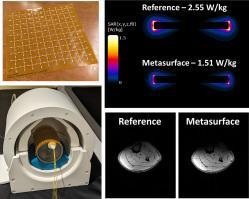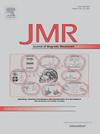Reduction of radiofrequency induced implant heating via flexible metasurface shielding at 7 T
IF 1.9
3区 化学
Q3 BIOCHEMICAL RESEARCH METHODS
引用次数: 0
Abstract
Passive implanted devices are commonly contraindicated at ultra-high field MRI due to the risk of radiofrequency heating. Mitigation of this risk has come in many forms, such as modifying implant materials or creating novel radiofrequency coils. These methods require substantial involvement from manufacturers and may not benefit patients with existing implants. In this study, a tailored metasurface design is demonstrated to improve implant safety at 7 T by shielding the local B1+ field. A prototype metasurface was designed and implemented with a unit cell size of 15 mm using discrete capacitors of 30 pF values. Phantom and human body model simulations were used to validate differences in the SAR distribution with and without the metasurface. Fiber optic temperature probes were used to measure temperature increase across two representative orthopedic screws placed inside a tissue mimicking phantom during a high-SAR sequence. Phantom and in-vivo imaging were performed to assess the metasurface effect on image quality. With the metasurface, an average maximum temperature decrease of 0.50 °C or 34.9 % near the implant was observed. RF field simulations yielded similar decreases in SAR for the phantom (40.7 %) and substantial decreases for the in-vivo leg model (97 %). Phantom image SNR showed a global 8.5 % decrease with the metasurface while in-vivo images showed a 4.8 % decrease in SNR, with the region in its immediate vicinity experiencing substantial signal drop. These results demonstrate the feasibility of a metasurface designed to substantially reduce local RF induced heating with only minor degradation of image quality. Future work will focus on refinement of the metasurface design and further in-vivo testing.

通过柔性超表面屏蔽在7 T下减少射频诱导的植入物加热
由于射频加热的风险,被动式植入装置通常禁止在超高场MRI中使用。减轻这种风险的方法有很多,比如修改植入材料或制造新型射频线圈。这些方法需要制造商的大量参与,并且可能对现有植入物的患者没有好处。在这项研究中,量身定制的超表面设计被证明可以通过屏蔽局部B1+场来提高7 T时种植体的安全性。设计并实现了一个原型超表面,其单元尺寸为15 mm,使用30 pF值的分立电容器。通过模拟和人体模型模拟来验证有和没有超表面时SAR分布的差异。在高sar序列中,使用光纤温度探头测量放置在模拟组织内的两个具有代表性的骨科螺钉的温度升高。幻影和活体成像评估超表面效应对图像质量的影响。在超表面下,种植体附近的平均最高温度下降了0.50°C或34.9%。射频场模拟对假体的SAR也有类似的降低(40.7%),对活体腿模型的SAR也有明显的降低(97%)。幻影图像的信噪比在超表面上整体下降了8.5%,而活体图像的信噪比下降了4.8%,其邻近区域的信号明显下降。这些结果证明了设计一种超表面的可行性,该超表面可以大大减少局部射频引起的加热,而图像质量只有轻微的下降。未来的工作将集中在改进超表面设计和进一步的体内测试上。
本文章由计算机程序翻译,如有差异,请以英文原文为准。
求助全文
约1分钟内获得全文
求助全文
来源期刊
CiteScore
3.80
自引率
13.60%
发文量
150
审稿时长
69 days
期刊介绍:
The Journal of Magnetic Resonance presents original technical and scientific papers in all aspects of magnetic resonance, including nuclear magnetic resonance spectroscopy (NMR) of solids and liquids, electron spin/paramagnetic resonance (EPR), in vivo magnetic resonance imaging (MRI) and spectroscopy (MRS), nuclear quadrupole resonance (NQR) and magnetic resonance phenomena at nearly zero fields or in combination with optics. The Journal''s main aims include deepening the physical principles underlying all these spectroscopies, publishing significant theoretical and experimental results leading to spectral and spatial progress in these areas, and opening new MR-based applications in chemistry, biology and medicine. The Journal also seeks descriptions of novel apparatuses, new experimental protocols, and new procedures of data analysis and interpretation - including computational and quantum-mechanical methods - capable of advancing MR spectroscopy and imaging.

 求助内容:
求助内容: 应助结果提醒方式:
应助结果提醒方式:


